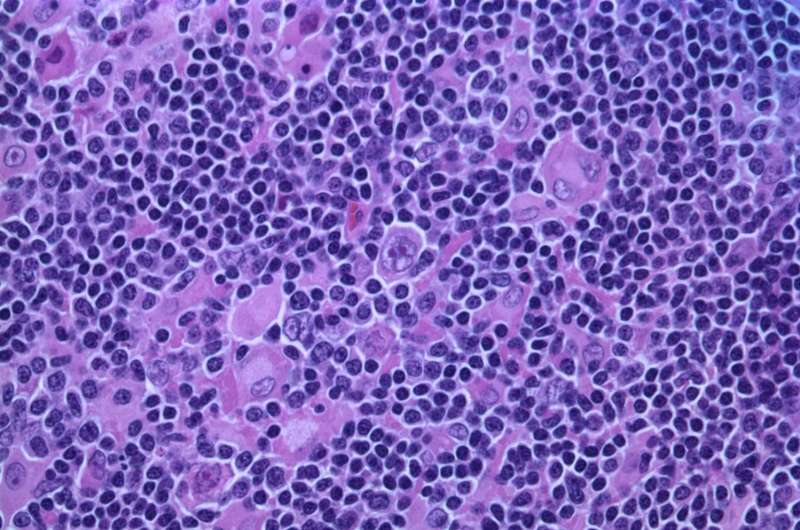Risk of age-related diseases may be higher in younger B-NHL survivors than in their older counterparts

Younger B-cell non-Hodgkin lymphoma (B-NHL) survivors had a higher relative risk of developing age-related diseases than older B-NHL survivors five years or more after cancer diagnosis, according to results published in Cancer Epidemiology, Biomarkers & Prevention, a journal of the American Association for Cancer Research.
In 2019, there were more than 700,000 NHL survivors in the U.S., with a five-year survival rate of 72.7 percent. NHL is most frequently diagnosed in people aged 65-74; however, some subtypes are diagnosed at younger ages and younger patients often undergo more aggressive treatment regimens.
"Thanks to therapy improvements, NHL survivors are living longer and thriving in many aspects," said study first author Krista Ocier, Ph.D., MPH, a postdoctoral researcher in the lab of Mia Hashibe, Ph.D., study senior author, professor in the Department of Family and Preventive Medicine at the University of Utah, director of Research and Practice for the Division of Public Health, and a Huntsman Cancer Institute (HCI) investigator. "However, side effects from the current treatment regimens can be debilitating over time, affecting the overall health of NHL survivors as they age."
The authors have previously established that younger NHL survivors have higher relative risk of specific heart and artery diseases than their older counterparts. In the present study, they evaluated the long-term risk of respiratory, renal, and other diseases related to aging, among younger versus older NHL survivors.
The study included data from 2,129 B-NHL survivors from the Utah Cancer Registry diagnosed between 1997 and 2015. Using the Utah Population Database, the authors matched up to five cancer-free individuals from the general population (8,969 individuals in total) with each B-NHL survivor, based on sex, age, and state of birth. They identified age-related disease outcomes through medical records from Intermountain Healthcare and the University of Utah, along with statewide health care facility data, and estimated the relative risk of these outcomes for younger and older B-NHL survivors (diagnosed at less than 65 years of age or more than 65 years of age, respectively) at least five years after cancer diagnosis.
Relative risks of acute renal failure, pneumonia, and nutritional deficiency were higher among younger than older NHL survivors compared with their respective general population cohorts: Compared with the general population, the risk of acute renal failure was increased 2.24-fold in younger survivors and 1.13-fold in older survivors; the risk of pneumonia was increased 2.42-fold in younger survivors and 1.44-fold in older survivors; and the risk of nutritional deficiencies was increased 2.08-fold in younger survivors and 1.25-fold in older survivors.
"This may be due in part to the aggressive treatment regimens that are often administered to younger non-Hodgkin lymphoma patients compared with older patients," said Ocier.
The researchers did not observe risk differences for other age-related diseases such as chronic kidney disease and osteoporosis between younger and older survivors, although NHL survivors have an overall elevated risk of these diseases compared with the general population.
"A key takeaway of this study is that earlier onset of age-related diseases is likely to occur among younger NHL survivors, therefore, periodic screening for a range of health outcomes and standardized care targeting these outcomes may be beneficial," said Ocier. "Our results also support the possible need for nutritional intervention during and after cancer treatment because nutritional deficiencies may impact the overall quality of life of B-NHL survivors, especially the younger ones, as they age."
Ocier added, "Cancer survivorship is an important area of research. We hope our study will be helpful for patients and their clinicians to understand what diseases may occur at a higher incidence after treatment is completed and will inform the creation of a plan for achieving optimal care and well-being during and after treatment."
While a strength of this study is the large sample size, a limitation is that there was a chance of missing some patient outcomes because researchers relied on diagnoses to capture the outcomes of interest. Another potential limitation is the survival bias; since mortality risk is higher for the older cohort, it is possible that some outcomes were not captured among the older patients.
More information: Age-Related Disease Risks in Younger versus Older B-Cell Non-Hodgkin's Lymphoma Survivors, Cancer Epidemiology, Biomarkers & Prevention (2021). DOI: 10.1158/1055-9965.EPI-21-0190




















